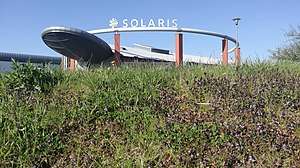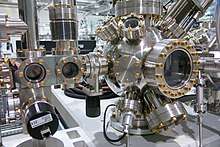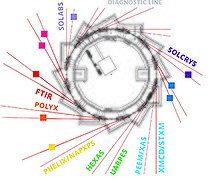Solaris (synchrotron)
Solaris is the first synchrotron built in Poland, under the auspices of the Jagiellonian University. It is located on the Campus of the 600th Anniversary of the Jagiellonian University Revival, in the southern part of Krakow. It is the central facility of the National Center of Synchrotron Radiation SOLARIS (Polish: Narodowe Centrum Promieniowania Synchrotronowego SOLARIS).[1]


The National Synchrotron Radiation Centre SOLARIS was built between 2011 and 2014. The investment was co-financed by the European Union with funds from the European Regional Development Fund, as part of the Innovative Economy Operational Programme for 2007-2013.
The SOLARIS synchrotron began operation with two beamlines (PEEM/XAS with two end-stations, and UARPES with one end-station). Ultimately, however, the experimental hall of the Kraków accelerator will house dozens of them. In total, the beamlines will be fitted with about twenty end-stations.[2]
It is named after the title of a novel by the Polish science fiction writer Stanislaw Lem, who lived and worked in Kraków.[3]
Research
The SOLARIS Centre is open for all interested scientists, both from Poland and abroad. Calls for proposals are announced twice during a year (in spring and autumn). The access to the infrastructure for scientists is free of charge.[4]
Beamlines
There are several beamlines.[5][6]
Active beamlines
The PEEM/XAS is a bending magnet based beamline dedicated to microscopy and spectroscopy in the soft X-rays energy range. The beamline is designed to study chemical and electronic, structural and magnetic properties by means of XAS, XNLD (X-ray natural linear dichroism) and XMCD (X-ray magnetic circular dichroism), XMLD (X-ray magnetic linear dichroism), respectively. It is suitable for probing element specific properties of surfaces, interfaces, thin films and nanomaterials. The available photon energy range (200–2000 eV) covers the absorption K edges for light elements, from carbon to silicon, L edges of elements with Z between 20 and 40, including 3d elements, and also M edges of many heavier atoms, including 4f elements. The offered experimental stations are: - a photoemission electron microscope (PEEM); - a universal station for X-ray absorption spectroscopy (XAS).
Both end stations are available for user's experiments in different sample environments and focusing conditions. Users can apply for beamtime with the PEEM or XAS end station. In order to prepare for their experiment, users are asked to look at the end stations' webpages.
UARPES - Ultra angle-resolved photoemission spectroscopy beamline allows for measurements of fundamental quantities, i.e. the energy and the momentum, describing a photoelectron state in the space outside the solid sample.
If a spin selector is used additionally, a complete set of quantum numbers for the electron may be obtained. Then, within a so-called sudden approximation, the electron energy, momentum and spin measured over the sample surface may be related, to binding energy, quasimomentum, and spin, that the electron had in the solid before the photoelectric event took place. Thus the electronic band structure of the studied solid is obtained experimentally. Beside this simple picture ARPES gives also detailed insights into complex electron – electron and electron – lattice interactions in the solid.
The importance of the ARPES technique for contemporary science and technology is widely recognized. Dedicated ARPES beamlines exist at almost all synchrotron radiation centers worldwide.
Applications: Many recent advances in materials science have been enabled by better understanding of the electronic structure of complex systems, gained due to ARPES studies. Examples include advances in fields such as: high temperature superconductivity, topological insulators, graphene physics.
Beamlines under construction
XMCD - the beamline will use variable polarization radiation, the source of which will be the EPU - elliptically polarizing undulator. Applications: the XMCD beamline include magnetic order research, domain structure research, imaging of chemical composition, biomolecular spectroscopy, and fluorescence detection.
PHELIX - PHELIX is a beamline using soft X-rays, the source of which is an APPLE II undulator with permanent magnets. Applications: new materials for spintronics and magneto-electronics, topological insulators, thin films and multilayer systems including samples obtained in-situ, surface of bulk compounds, surface magnetism, spin polarized surface states, chemical reactions taking place on the surface, and biomaterials.
SOLABS - an X-ray absorption spectroscopy beamline, whose synchrotron light source will be a bending magnet. The line will deliver photons within a broad energy range, allowing measurements to be conducted at the absorption edges of many elements.
Applications: The endstation will be intended for materials research of both a basic and applied nature. SOLCRYS - a wiggler-based, high energy X-ray beamline (up to 25 keV) for structural studies. Applications: in structural studies (biological, macromolecular, pharmaceutical, crystalline materials, etc.) also performed under extreme conditions (high pressure, temperature).
Planned beamlines
FTIR an absorption infrared microscopy beamline (FTIR) with imaging. Applications: biomedicine, nanotechnology, environmental sciences and many others. The planned studies will facilitate, among others, synthesis of potential medicines and their design.
POLYX - a beamline which will enable high-resolution multi-modal imaging in the hard X-ray range. Applications: the POLYX beamline may be used for testing new solutions in X-ray optics and detectors.
STXM - the end station for scanning transmission microscopy which will comprise an element of the XMCD beamline. Applications: The device will enable, among others, nanoscale chemical analysis via a combination of X-ray absorption spectrometry and microscopy.

Parameters
The SOLARIS storage ring main parameters:[7]
- Energy: 1.5 GeV
- Max. current: 500 mA
- Circumference: 96 m
- Main RF frequency: 99,93 MHz
- Max. number of circulating bunches: 32
- Horizontal emittance (without insertion devices): 6 nm rad
- Coupling: 1%
- Tune Qx, Qy: 11.22; 3.15
- Natural chromaticity ξx, ξy: -22.96, -17.14
- Corrected chromaticity ξx, ξy: +1, +1
- Electron beam size (straight section centre) σx, σy: 184 µm, 13 µm
- Electron beam size (dipole centre) σx, σy: 44 μm, 30 μm
- Max. number of insertion devices: 10
- Momentum compaction: 3.055 x 10-3
- Total lifetime of electrons: 13 h
References
| Wikimedia Commons has media related to Synchrotron Solaris. |
- Synchrotron Solaris official website
- "Beamlines". Synchrotron SOLARIS -official website.
- "Cyclotron and Solaris", welcometo.pl, March 22, 2017
- "Research". Synchrotron Solaris - official website.
- "Beamlines". Synchrotron SOLARIS-official website.
- "SOLARIS leaflet". Synchrotron SOLARIS - official website.
- "Storage ring". Synchrotron SOLARIS - official website.